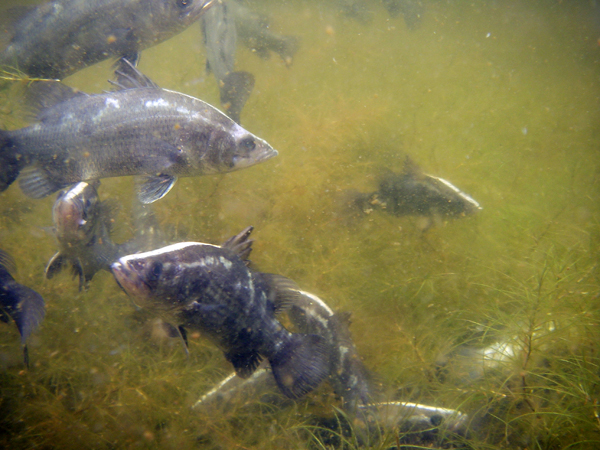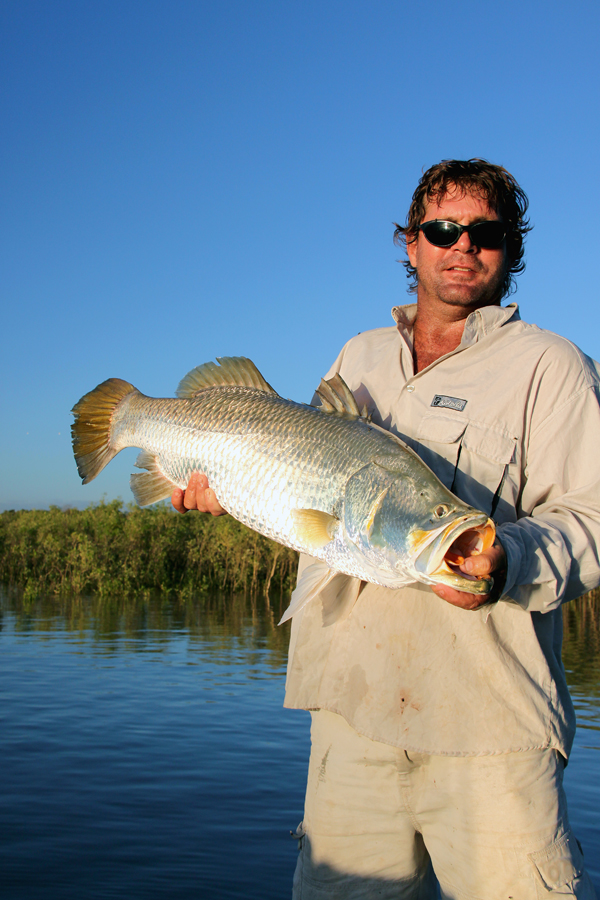By Dr Thor Saunders - Principal Fisheries Scientist
BARRAMUNDI abundance in river catchments is heavily influenced by both the amount of rain from the current and previous wet seasons. Good wet seasons inundate floodplain habitat within the catchment, providing increased food to larger barramundi which enhances their growth and survival. Additionally, during a good Wet, the barramundi are heavily concentrated in specific areas (such as feeder creeks running off the floodplain to the main river) making them easier to target by fishers. Floodplain habitat also provides food and protection to small barramundi that have been born during that year so a big Wet means more juveniles surviving. The effect of increased juvenile survival is often seen years later when those fish grow to legal size. During poor wet seasons, the opposite is true with growth and survival of larger barramundi decreasing and often very few juveniles survive to make it to legal size. Additionally, the barramundi need to find alternative food sources and ‘spread out’ in the river catchment, making them more difficult to catch.
MONITORING BARRAMUNDI ABUNDANCE NT Fisheries monitors the barramundi populations in the Mary and Daly rivers using four different methods:
Abundance surveys An electro-fishing vessel is used to run transects at three to six locations in the river. The electro-fisher generates an electrical field in the water at the front of the vessel and ‘stuns’ any fish that comes into contact with that field, allowing them to be netted, tagged and measured. This process does not harm the fish so they can be released back into the water once they have been tagged. The abundance of barramundi is calculated by the number of fish caught divided by the distance of the transect.
Tagging Recaptures of tagged barramundi provide information on the harvest rate of this species by dividing the total number of tagged, harvested barramundi by the total number that was tagged in the first place.
Year class strength This analysis involves ageing a sample of barramundi representing the range of size classes in a river system. The fish are aged by counting rings from their otoliths (ear bones) and this information provides an abundance estimate of each age class of barramundi in the river. By doing this, over multiple years ‘high abundance’ age classes can be tracked back to when they were born and what environmental factors caused high or low juvenile survival.
Monitoring of Commercial and Fishing Tour Operator logbooks These daily records of barramundi catch and effort allow catch rates to be calculated that can be used to approximate abundance; eg high catch per unit of effort indicates high levels of abundance.
STOCK STATUS OF BARRAMUNDI IN THE NT All of the information from these monitoring methods, in conjunction with our knowledge of the biology of barramundi (high growth and high egg production), allow the populations of barramundi in any river to be assessed. For both the Daly and Mary Rivers, the barramundi populations are being fished well within sustainability limits. Abundance surveys indicate regular annual recruitment and a good range of size classes of mature fish. Tag recaptures indicate that the harvest rate of barramundi is below 5% for both systems, including the commercial harvest at the mouth of the Daly River. Analyses of the commercial and Fishing Tour Operator logbooks indicate that catch rates were at record levels up until 2012.
WHAT HAPPENED IN 2013? However, as the first paragraph suggested, barramundi abundance can fluctuate from year to year due to the variability in the strength of the wet season. Barramundi populations were probably at record highs during 2012 on the back of regular, above average, wet seasons in the previous 8 years, including two exceptional wet seasons in 2011 and 2012. During 2013, the rivers were in flood for less than 10 days. Looking at historical data, the last wet season this poor was in 1992 and, before that, in the 1980s when there were several bad wet seasons in a row. A poor wet season can have a huge impact on the abundance of barramundi as there is simply not enough food around for them all to survive. This mortality seems to have impacted the fish that were 60-80cm in length in 2012. This was the most abundant length class being caught by fishers before 2013 and now they are rarely caught. Why this size class suffered the most is unknown but it is probably a combination of these fish becoming trapped in billabongs where they died due to the rivers rising and falling so fast, prey items for this size fish becoming extremely rare due to the poor wet season and competition/predation by larger barramundi that remain in good numbers.
However, despite the poor wet season, there are still large numbers of large 90cm-plus barramundi and very high numbers of 50-60cm fish from juveniles spawned in 2011 and 2012. And with less competition from there being fewer 60-80cm fish, they will grow very quickly!
For all of these reasons, the barramundi populations in the NT are still considered exceptionally healthy and highly sustainable.








